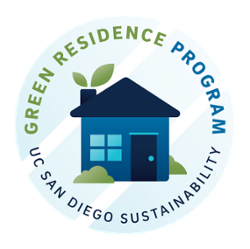
Green Residence Program
Learn how you can conserve resources and save money whether you’re living on campus or working remotely from home.
Program Goals
The Green Residence Program strives to:
- Increase sustainability education and awareness throughout the campus community
- Provide information about how students, faculty and staff can implement best practices in their homes
- Reduce resource consumption
Self-Assessment
The Green Residence Self-Assessment consists of several behaviors that allow you to evaluate your current practices and gives you a score upon completion. At the end of the assessment, you have an opportunity to share additional sustainable practices that were not included.
Instructions: Complete this survey by choosing how often you engage in the actions (e.g.: 3 out of the 4 times I ordered food delivery this week, I refused utensils and napkins). We encourage you to research any questions you are unsure how to answer (e.g.: Is my Angel Soft toilet paper sustainable?).
Assessment Levels
After you complete the Green Residence Self-Assessment, you should receive an email with your score. The Assessment Levels below let you see where you rank.
Thank you for completing the self-assessment and doing your part to conserve our planet’s resources!
 |
Conservation Champion (76–100%) You are one with the planet and a true example to follow! Being green isn't as easy as you make it look. You understand the significant impact that individual actions have on the environment. Others look to you for guidance so share your insight and assistance whenever you can. |
 |
Planet Protector (51–75%) You are doing a great job protecting the planet! You choose to be green and overcome sustainability challenges. You recognize that your actions can transform the world. We need more people like you to make a difference. |
 |
Environmental Enthusiast (26–50%) Your enthusiasm for the environment is evident! You have taken steps to incorporate sustainable alternatives in your daily life. Seek out others who can lead you further in your journey. Align with the green forces because we are all in this together. |
 |
Sustainability Steward (</=25%) You are actively making an effort to be more sustainable! Remember that the best way to protect the future is to protect the planet. Ask a friend to join you in taking those baby steps closer to living sustainably. Together you can understand, recognize, and incorporate better habits into your routines. |
Tips
Explore the tips below to understand the environmental impacts of particular behaviors and to learn how you can implement more sustainable best practices into your daily routine.
Phantom Load
Not all devices shut down completely when powered off. Some equipment enters a standby mode and still draws power from an outlet. This is known as phantom load and it can contribute to up to 10% of household power consumption and 1% of greenhouse gas emissions. A good practice is to unplug appliances, electronics and devices when not in use. Learn more about phantom load from this article on How Stuff Works.
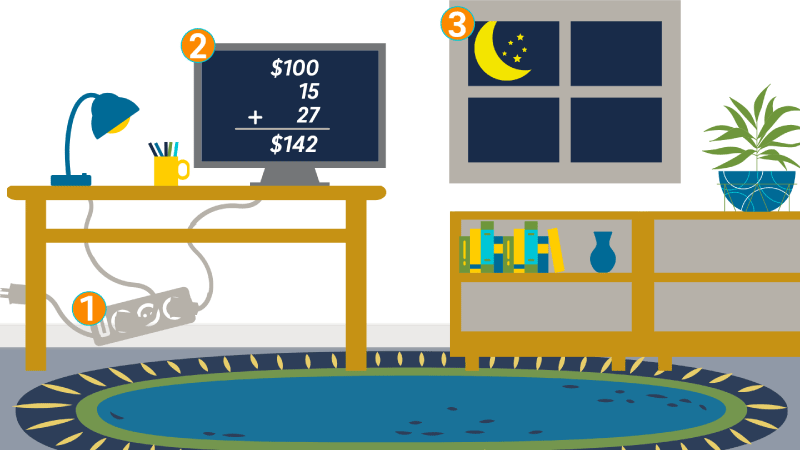
Here’s how you can eliminate phantom load.
- Plug computer(s) and electronics into power strips. Switching off power strips at the end of the day reduces phantom load. According to this Hero Power article, power strips can cut electricity usage by 20-48%, saving Americans $200 annually on average.
- Set your computer to a 15-minute or less sleep mode. This reduces energy consumption by 90% and can save you up to $15 per computer annually. The ENERGY STAR website offers resources for setting your computer to sleep mode.
- Turn off your computer at the end of the day. This can save you as much as $27 per year. This Simple Dollar article offers eight energy-saving tips for your computer.
Energy Use
When you use electricity matters. Energy time-of-use refers to different energy pricing depending on the time of day. You should know when energy is the cheapest in your area and plan activities accordingly.
If you need new appliances, electronics, including computers, or a new heating and cooling system, ENERGY STAR® rates products based on their energy consumption and rebates are often available for ENERGY STAR-rated products.
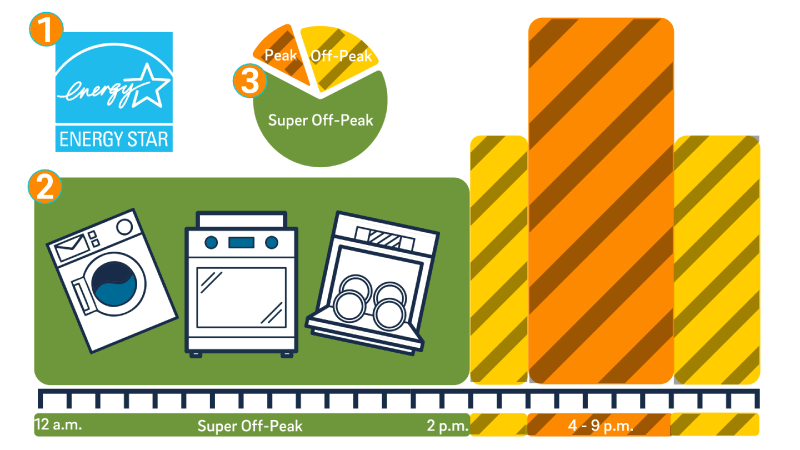 Here’s how you can save energy and money.
Here’s how you can save energy and money.
- Familiarize yourself with ENERGY STAR-rated products. ENERGY STAR® is a program that provides energy consumption information on various products, such as appliances, home electronics, computers, lighting, and heating and cooling systems. It is run by the U.S. Environmental Protection Agency and the U.S. Department of Energy. The ENERGY STAR® label on a product means that it saves energy and money. ENERGY STAR offers rebates on their website by zip code. Save on Energy provides examples of savings by category.
- Check your energy plan. Peak hours are the times during the day when energy demand in your city is at its highest. The price per kilowatt-hour will be higher during peak periods. For example, peak hours with SDG&E in San Diego are from 4-9 p.m. Conserve energy and save money by using high-energy consumption appliances, such as the dishwasher and washing machine at super off-peak hours. Spark Energy has ranked the appliances that use the most energy.
- Make the switch. Calculate your energy consumption using this Appliance Energy Calculator. Your monthly energy statement will display your usage by peak and off-peak time. Set a goal to use the most energy during off-peak hours.
Dishwashing
An ongoing debate exists over whether using a dishwasher or handwashing dishes is more sustainable. However, you should consider many factors when determining which option is more sustainable for your household, including volume, dishwasher age, and whether or not the machine is ENERGY STAR® rated. Ultimately, each option has pros and cons.
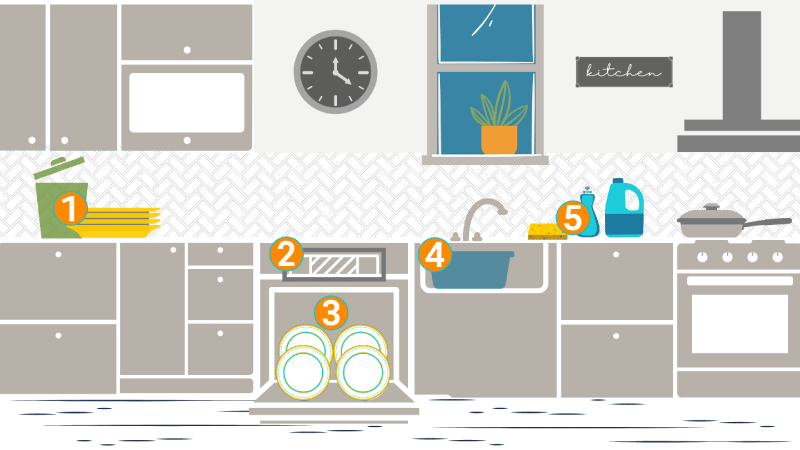
- Scrape off food and do not pre-rinse dishes. Scrape food into a compost bin, if you have one. If your sewage flows through a treatment facility, you can use the garbage disposal for soft food scraps (no bones). Scraping dishes as opposed to pre-rinsing them before running the dishwasher saves water.
- Use the appropriate dishwasher settings. Choose normal wash and avoid using the heavy cycle and heat-dry The heavy wash cycle takes longer and can use up to 2.5 times more water and energy than a normal wash. When selecting the dishwasher drying setting, consider using the air-dry setting rather than heat-dry, which uses 15% more energy. This Earth911 article ranks the ten greenest dishwashers and provides information about eco-friendly settings.
- Run the dishwasher at full capacity. This saves energy and water. Dishwashers manufactured on or after May 30, 2013 cannot exceed five gallons of water use per cycle as regulated by the Department of Energy. Handwashing dishes could use up to 27 gallons of water. When comparing a full load of dirty dishes, machine dishwashing is more efficient than washing dishes by hand.
- When handwashing dishes, use the two-basin method. The lesser-known two-basin method is the ideal dishwashing method in terms of sustainability. This is when dishes are soaked and scrubbed in one basin of hot water and then rinsed in another basin of cold water. This of course is easiest if you have a two-basin sink, but a removable tub also does the trick. Using the two-basin technique can reduce greenhouse gas emissions from washing dishes up to 18%. This Consumer Reports article explains how this technique can save energy and perhaps get dishes cleaner.
- Purchase environmentally friendly dishwashing products. Choose dish soaps from environmentally conscious companies that do not contain harsh and destructive chemicals, such as phosphate and chlorine, which have negative effects on sea life. This Treehugger.com article describes what to look for in dish soap and it rates the Best of 2021. Another way to practice sustainable dishwashing is to purchase environmentally friendly dishwashing supplies, including sponges, scrubs and drying towels. Most common dishwashing materials contain microplastics that go down the drain and harm marine life. Sustainably Lazy offers 15 alternatives to using a plastic sponge.
Laundry
Doing laundry is one of the most resource-intensive chores. You can make changes to your routine that will save energy, water, money and help the environment. It may not be the most glamorous way to spend a break from work or studying, but consider doing a load of laundry before you start your day or using the time during one of your breaks to hang the laundry. Running the washer during off-peak energy hours will save energy and money. Some washing machines have multiple buttons. Learn what each setting does, and which ones are the most efficient for your needs. The type of laundry products that you use makes a difference too. Know what ingredients are in your detergent and other cleaning products to ensure that they are safe for the environment and for your family.
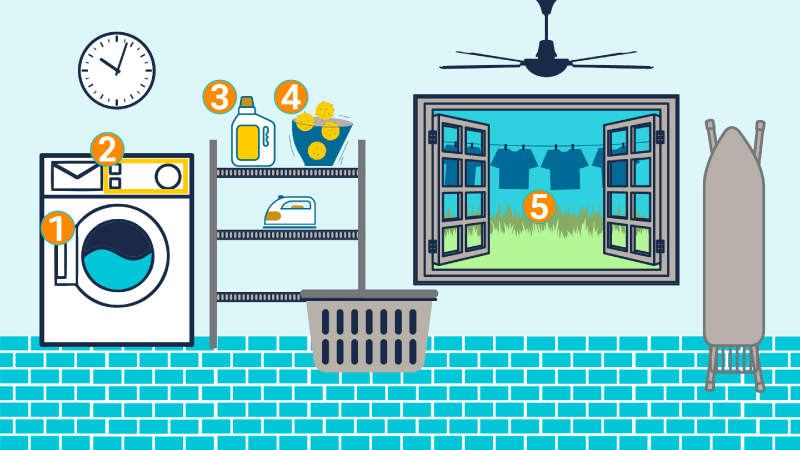
- Run washer at full capacity. Run the washing machine when you have enough laundry to fill it. Running half or smaller loads will use less water and energy than a full one if you use the appropriate-size settings, however running two smaller loads uses more resources than one full load does.
- Wash with cold water using the normal or eco settings. Energy consumption from most washing machines goes towards heating the water. Washing in cold water can save up to 70-90% of the energy required and prevents damaging your clothes. A common misconception is that all clothes and washable materials must be washed in warm water to kill bacteria. This is only true for items like undergarments and towels. Washing fabrics in warmer water can actually fade and shrink them. Always check your clothing tags to ensure that you can use cold water when washing. Learn more about why cold water is more efficient in this GE Appliances article. The settings that you choose are just as important as the water temperature. Choose the most appropriate setting for the load size. This News for Kids article describes how gentle cycles use more water, which releases more microplastics. These tiny pieces of plastic fibers come from fabrics made from synthetic materials, such as nylon, polyester, and acrylic. Synthetics release microplastics when washed, worn or dried. These nearly invisible particles are incredibly harmful to marine life.
- Purchase environmentally friendly laundry detergent. Harmful chemicals are not always effectively filtered out during washing cycles and end up in the ocean. Review the list of 2021 Best Eco-Friendly Laundry Detergents.
- Use dryer sheet alternatives. If you are using a dryer, consider using dryer balls instead of single-use dryer sheets. Dryers can release up to 3.5 more microplastics than washers. Some reusable dryer balls are designed to catch microplastics released from clothes. Read more about dryer balls.
- Hang or air-dry clothes. This Green America article provides several reasons not to use a dryer. Most notably is that the dryer is the third-most energy-intensive appliance in your home following the refrigerator and washer. Line drying clothes not only reduces your carbon footprint by 2,400 lbs. per year, but it can also preserve your clothes.
Heating and Cooling
Heating and cooling can account for half of a home’s electricity use. We’re fortunate living in San Diego where the temperature is consistently moderate. When we do experience the temperature extremes, you can implement several strategies that don’t involve adjusting the thermostat to keep your home at a comfortable temperature.
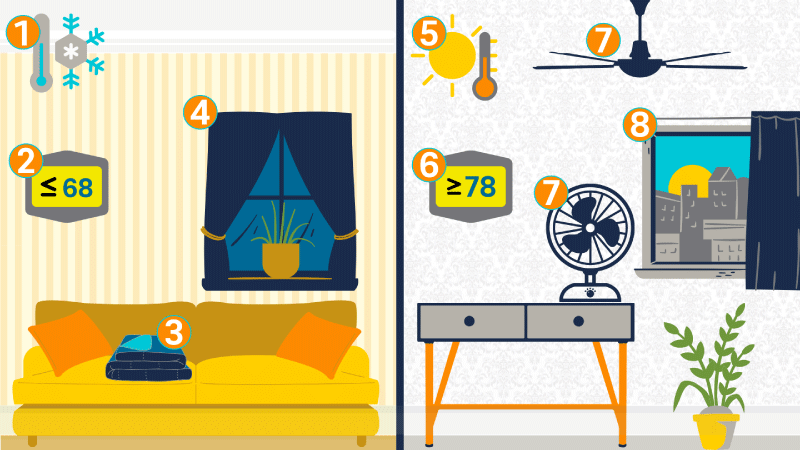
- On cooler days...
- Set your thermostat to 68 degrees or lower. Save energy by setting the thermostat to 68°F when you're awake and 58° when you’re sleeping. Energy.gov notes that lower interior temperatures result in slower heat loss, contributing to energy conservation as well as saving you 5%–15% on your annual energy bills.
- Wear a sweater or use a blanket. Instead of turning on the heat, wear layers to regulate your body temperature. The Balance offers other great tips to avoid turning on the thermostat on cold days.
- Use curtains to regulate room temperature. In cooler conditions, curtains can keep heat from escaping. Carefully choosing different types of blinds and curtains can further assist in regulating indoor temperatures. Insulated curtains could reduce energy loss up to 25%. You can open curtains or blinds to let direct sunlight warm the room.
- On warmer days...
- Set your thermostat to 78 degrees or higher. Setting your thermostat to a temperature closer to the outdoor temperature will lower your energy bill. When you are home, set your thermostat to 78° F or a tolerable warmer setting. Keep your home even warmer when you are gone for the day or away on vacation.
- Use ceiling or portable fans. An air conditioning unit uses roughly 5-9 times as much electricity as a fan. On average, a fan at medium speed consumes 66 watts of electricity, whereas an air conditioning unit consumes 460 watts of electricity. Learn more about keeping your home cool and energy efficient.
- Open or close windows to regulate room temperature. Always keep windows and doors closed when running the air conditioner so cooled air can’t escape and the AC unit doesn’t need to work harder than necessary. Closing blinds on windows that are exposed to direct sunlight will prevent UV light from entering and heating the room. Open panes of shaded windows to help circulate air in the room when not using air-conditioning.
Lighting
Proper lighting is important for the task at hand. Poor lighting can cause eye strain, headaches and migraines. Here are some of the easiest ways to conserve energy and save money

- Use natural lighting when possible. Add opening the blinds or curtains to your morning routine. This allows you to determine how much natural light is present before turning on any lights. You can cut up to 22% of your energy usage by using natural lighting. It also offers several health benefits, including an increase in vitamin D and improved sleep.
- Turn off lights when not in use and at the end of the day. Extend the life of your lightbulbs by only using them when needed. Make it a habit to turn lights off whenever you leave a room and at the end of the day. If you forget to turn lights off, consider using an outlet timer to set a lamp to turn on and off at desired times.
- Use task lighting instead of overhead lighting. Task lighting illuminates a particular area for a specific task, like a desk or table lamp. Overhead lighting fixtures cast light downwards from the ceiling, such as a chandelier, recessed lights, track lights, pendants, etc. In most cases, overhead lighting fixtures utilize multiple bulbs and therefore use more energy, whereas task lighting uses just one bulb. Learn more about when to use which lighting source.
- Choose LED when replacing light bulbs. We throw away about 670 million fluorescent lights each year in the United States, resulting in about four tons of mercury waste. LED lights use 75% less energy and last 25 times longer than incandescent bulbs. UC launched the Million LED Challenge in 2018 to make purchasing LED lighting easy and more affordable. Home Depot and Lowes offer resources on various types of bulbs. The City of San Diego provides information about how to dispose of lightbulbs properly.
Printing
Once, the average office employee used an estimated 10,000 sheets of paper annually. Fewer people are printing now with the shift from physical paper to digital. The COVID-19 pandemic resulted in people working and studying from home without the ability to exchange paper documents, like journal entries, reports and final papers. Online collaborative platforms such as Google, Microsoft Teams, Zoom and Slack have made it possible for people to share, view and edit files in real-time. The need to print is becoming less necessary.
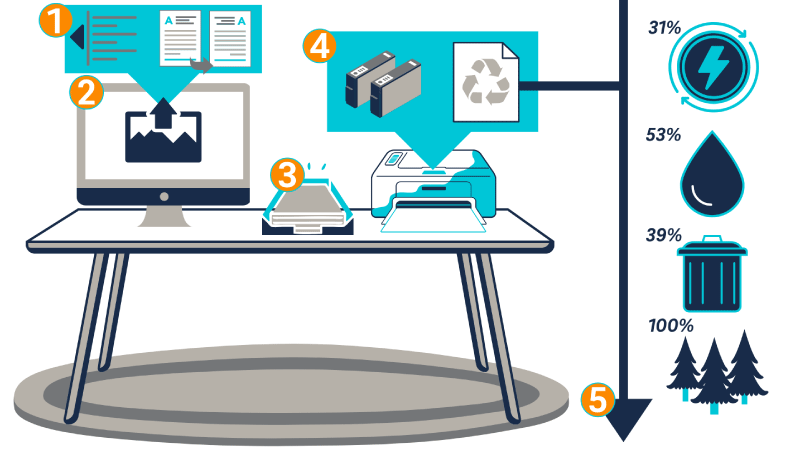
- Set margins to less than one inch and print double-sided. Setting margins to one inch or less increases the number of words that can fit on a page, which often results in printing fewer pages. Set printer default to double-sided print and confirm this setting is displayed in your print preview before sending it to the machine.
- Use and send electronic documents. Only print physical copies of essential documents. Send items electronically rather than printing and mailing. Many virtual signature methods are now available. Read about the pros and cons of digital vs printed documents.
- Use a bin to collect good-on-one-side paper. This makes it convenient to print on paper that is blank on one side or to find scratch paper. Avoid using a new piece of printer paper for notes and lists when possible.
- Refill ink in and toner cartridges. Visit your local office supply store and inquire about ink and toner cartridge refill and recycling. In the U.S., more than 40,000 tons of plastic and metal are saved from landfills annually due to cartridge recycling. For every 100,000 used cartridges recycled, we can save 9,599 kilograms of aluminum, 40 tons of plastic and 1,000,000 liters of oil.
- Purchase at least 30% recycled paper. This Green America article explains how choosing 100% recycled paper reduces energy consumption by 31%, water consumption by 53%, solid municipal waste by 39% and tree use by 100%.
Waste and Recycling Guidelines
Let's get back to the basics by reviewing some general waste guidelines. A great way to start reducing your environmental impact is to conduct a waste audit to identify how you can send less to the landfill. Follow the city’s guidelines whenever placing items in recycling, trash, or compost. Cities have different guidelines and waste collection companies within cities may have specific requirements.
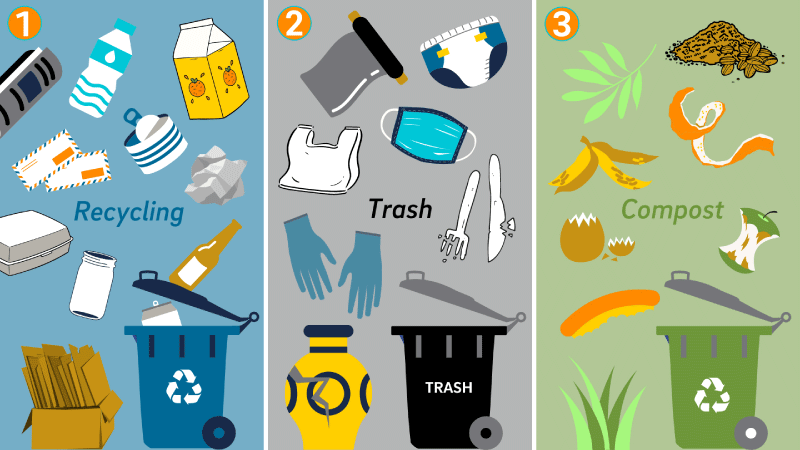
- Recycle properly by following city guidelines. Recycling is a complex system and you need to know what goes where. Just because you see the recycling logo on an item does not mean it is recyclable in your city. Check which recycle numbers your local recycler collects. High contamination can result in recyclables being sent to landfill. One way to avoid this is to rinse your recyclables before placing them in the bin. A good rule to stick by is that nothing in a recycling bin should be wet or smell bad. Learn more about how to recycle properly in San Diego by visiting the City's webpage.
- Conduct a personal waste audit. Select a week or longer to sort the waste you’ve collected into similar groups. For example, put all soiled paper products in one pile, clean paper products in the other. Use a spreadsheet or notepad to record what is in each pile. Once you have audited the waste produced in your household, think about reasonable alternatives you can implement to prevent certain items from routinely entering your waste stream. Use this Earth911 guide for tips on how to conduct a personal waste audit.
- Compost food scraps and yard clippings. Composting, or organics recycling, is a simple way to divert food scraps and yard clippings from the landfill and reduce greenhouse gas. There are a variety of ways to compost at home and many cities either provide the service to residents or independent companies will collect for a fee. Currently, the simplest way to compost on campus is to drop off your food scraps at one of the student gardens.
Waste Reduction
By definition, using something once and throwing it away is wasteful. We all should be looking for ways to reuse considering how Americans send roughly 140 million tons of waste to the landfill each year. Reusing can be challenging for some people because it requires them to wash, charge, separate or remember to bring something with them wherever they go. Being sustainable and conserving isn’t easy. Single-use options are convenient and can be used at specific time but not routinely.
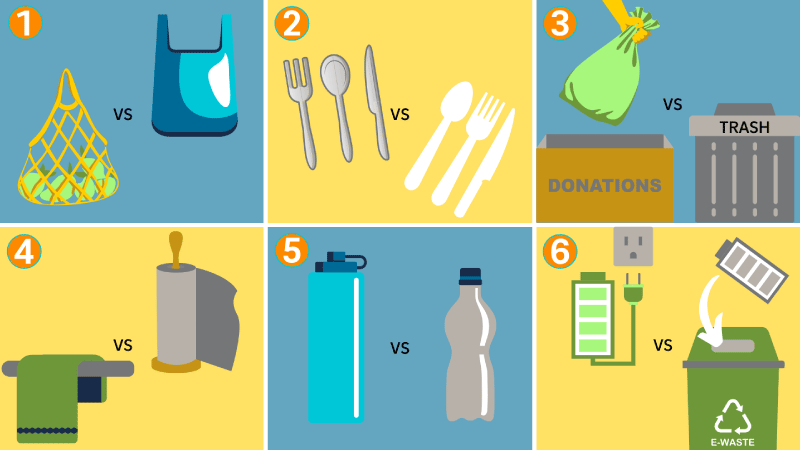
- Choose the most sustainable shopping bag option. Always try to remember to bring reusable shopping bags whenever you go to the store. Keeping reusable bags in your car can help. If you forget your reusable bags, ask for paper instead of plastic. You can recycle paper bags in your curbside bin whereas plastic bags require store drop off to be recycled. If you do take a "single-use" plastic bag home, try repurposing it at least once before discarding it. Americans use about 100 billion plastic bags per year, which requires about 12 million barrels of oil to manufacture. Choosing reusable bags can significantly reduce your environmental impact.
- Refuse single-use utensils and napkins when ordering take-out or food delivery. According to the Plastic Pollution Coalition, Americans use more than 100 million pieces of plastic utensils every day. You can do your part by refusing those single-use items when ordering take-out or food delivery. If your items are already bagged when you arrive, check to see if you received plastic utensils before you leave and ask the restaurant to take them back because you don’t need them. Many popular food delivery services, such as Uber Eats, Postmates, Grubhub and DoorDash, allow you to indicate on their app that you do not want utensils before checking out. When ordering by phone, ask the individual taking your order to note that you do not want utensils so the person bagging your order is aware.
- Donate usable items instead of throwing them away. Donating items in good condition that someone else could use contributes to the cycle of reuse while diverting items from landfills. Goodwill and the Salvation Army are two of the many San Diego organizations that are committed to providing unwanted items a second home. Both offer many drop-off locations. If you are looking to trade in clothing items for money or store credit, check out the thrift chain Buffalo Exchange or ThredUp Other online methods for selling items include Depop, Facebook Marketplace and Offer Up.
- Use washable kitchen rags or towels instead of paper towels. According to The Atlantic, Americans use more paper towels than any other country in the world. The simple solution is to use reusable towels or rags. Sure there are times when you just need a paper towel, but this medium.com article offers a solution for those situations. If you do find yourself still needing to purchase paper towels, be sure to buy from an environmentally conscious brand that uses recycled content or traditional paper alternatives such as bamboo. If you’re wondering if paper towels or hand dryers are better, read this article.
- Do not buy Individual water bottles. Bring a reusable water bottle when you leave the house! Never buy plastic water bottles as an alternative to drinking tap water; instead, buy a water filtration system, such as a handheld Britta jug. This may seem like old news, but plastic water bottle consumption increases by 10% each year. Learn more about how destructive plastic water bottles are to the planet. While on campus, fill up at one of 125+ hydration refill stations.
- Use rechargeable instead of single-use batteries. If you use batteries on a regular basis, try replacing single-use batteries with rechargeable ones that can be used up to 500 times, potentially diverting 500 batteries from the waste stream. Rechargeable batteries can be used in computer mice, toys, solar lights, battery-powered holiday lights and clocks. Visit Call2Recycle to learn more about the difference between rechargeable and single-use batteries and find a drop-off location near your with their interactive map.
Bathroom Products
Do you know what’s in your bathroom products? You should know what ingredients or materials were used to ensure that a product was made sustainably and in a socially responsible manner. The product packaging is almost as important. Consider how you will properly dispose of the container or wrapping when purchasing a product. Exercise your purchasing power by supporting ethical companies that care about people and the planet.
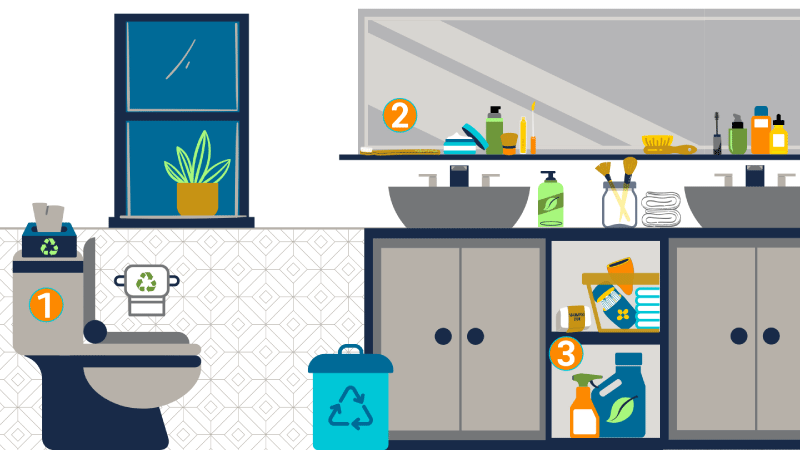
- Purchase sustainable paper products. Not all toilet paper is made the same way. In fact, 15% of total deforestation is a result of toilet paper production. In 2020, the Natural Resources Defense Council produced a tissue scorecard ranking the sustainability of toilet paper, paper towels and facial tissue. You may think twice before reaching for that name brand product. Explore the best sustainable options available for menstrual products.
- Make or refill at least one of your cleaning or beauty products. Almost 7.9 billion units of rigid plastic were created in 2018 for beauty and personal care products. Some companies are producing beauty care products in sustainable containers to reduce packaging waste. One of the hottest new trends is refill stores, like Earthwell Refill, that offer quality natural products that you can purchase using your own container. The internet has a wealth of resources for making your own homemade beauty products and cleaning solutions. Sustainable alternatives for toothbrushes, mouthwash, and other oral care products are available from sites like Eco Girl.
- Purchase sustainable cleaning products. This Reader’s Digest article describes the 13 most toxic spring-cleaning products. Green Seal Certified products are proven to be green and healthier. Brands such as Mrs. Meyer's, Method and Seventh Generation are committed to producing environmentally conscious products and you can find them at most retail stores. This NBC News article rates the 15 best eco-friendly cleaning products according to experts. If you also want to reduce plastic, consider companies like JAWS that sell reusable spray bottles and non-toxic concentrated pods of cleaning solution.
Bathroom Water Use
Bathroom water use accounts for up to 75% of indoor household water consumption. You may not realize it but flushing the toilet multiple times a day uses more water than showering or washing your clothes. If you’re not in the market to replace your toilet with a low-flow model, consider purchasing a Toilet Tank Bank or DIY it with a plastic water bottle filled with rocks. Discover the other types of water conservation devices that can make a real difference.
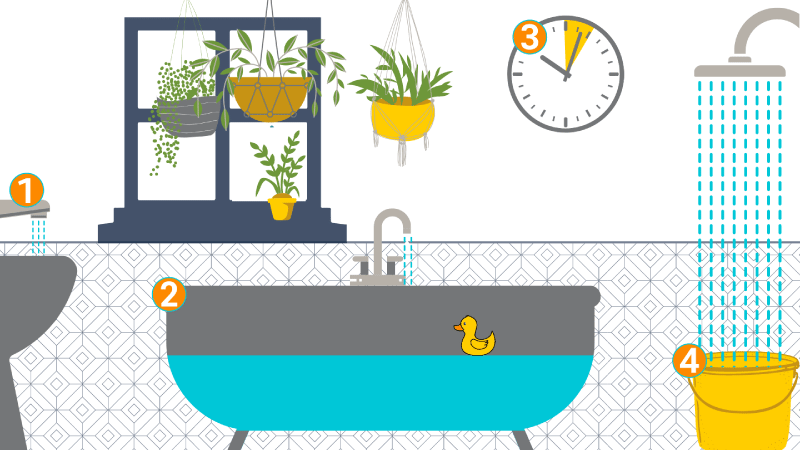
- Turn off the tap while lathering your hands with soap or brushing your teeth. The average faucet flow rate is 1-5 gallons per minute. Here’s how you can save a significant amount of quality, clean water each day.
- When washing your hands, the Center for Disease Control recommends lathering for 20 seconds before rinsing. Turn off the tap after wetting your hands, lather with soap, then rinse.
- When brushing your teeth, the American Dental Association recommends two minutes twice a day. Turn the faucet off after wetting your toothbrush, brush your teeth, then rinse.
- Draw a bath sustainably. The average bathtub flow rate is 4-7 gallons per minute, so being water conscious when bathing can have a large environmental impact. Rather than wasting cold water, plug the drain and begin to fill the tub with cold water. As the water warms, it will mix with the cold water bringing the water to a comfortable bathing temperature. Only fill the bathtub halfway.
- Limit water use when showering to five minutes or less. This EPA flyer lets you calculate your bathroom water use savings, based on average shower time. According to the calculation, if you take a six-minute shower seven days a week, you use 4,586 gallons of water per year. Taking a five-minute shower reduces annual water use to 3,822 gallons, saving up to 764 gallons. Use your own shower time to see how much you can save. Consider turning off the shower while lathering your hair or body with soap and when shaving. This Cleveland Clinic article offers guidance about how often people need to shower. Learn how often you should wash your hair based on your hair type.
- Take cooler showers. Heating water for a warm shower can produce up to 250 pounds of carbon dioxide per person annually. Taking a cold shower saves energy and has significant health benefits. For example, studies show that cold-water immersion can lower heart rate and blood pressure levels. Cold showers can also have mental health benefits. This Ted Talk by Joel Runyon talks about how cold showers helped him to view the world from a new perspective. Everything in moderation: try to incorporate the habit of cold showers in a way that works best for you, possibly once or twice a week.
- Collect cold water while the shower heats up. If taking a cold shower isn’t your thing, consider that the flow rate of an average shower head is about 2.1 gallons per minute. That means that if you let your shower heat up for only three minutes without collecting the water, you are potentially wasting about six gallons of water. Conserving every drop of water is important, especially in drought-prone states like California. Read more about the benefits of using a shower bucket and the many ways to use the water you collect.
Food Waste
By planning meals and grocery lists ahead of time, you reduce the potential for wasting uneaten perishable foods. Here are some easy ways to reduce food waste.
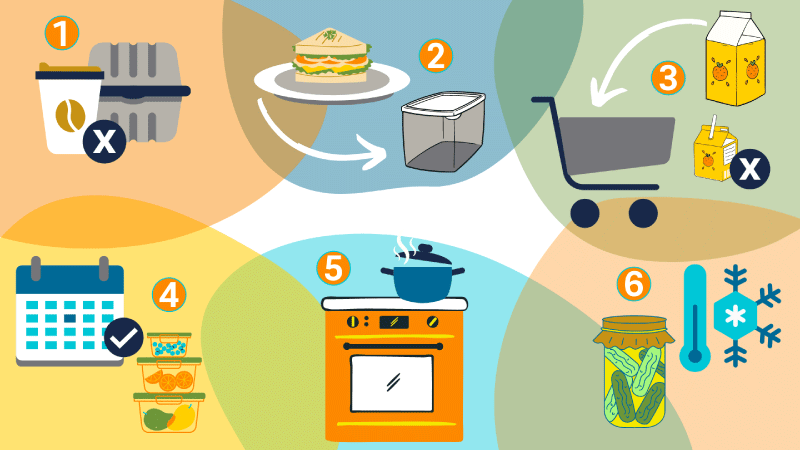
- Avoid ordering takeout. Takeout is inherently wasteful due to the single-use containers for serving the food. You should only get food to go when you’re on the road and need to grab a quick bite to eat. If you are unable to avoid takeout, there are several ways to make ordering takeout less wasteful. First, note on the app or inform the individual taking your order that you do not need utensils, napkins, condiments or a bag. Make sure that you properly dispose of takeout containers, which includes rinsing them, if needed. You can also reuse them in other ways.
- Eat what’s on your plate. Take only what you can eat and eat what you take! You can go back for seconds. In the U.S., about 40% of food produced ends up in the landfill. Carry a food container with you so that you can save your leftovers for later if you cannot finish your meal. Reduce single-use plastic in the kitchen by storing leftovers in reusable containers. Replace plastic wrap with beeswax-based food wrap.
- Buy in bulk to reduce packaging waste. Purchasing grocery items in bulk helps to avoid individually packaged items. Rather than buying individual yogurt or juice cartons, select the large tub or gallon sizes. If you need to take individual sizes on the go, try reusable containers to transport smaller portions. Some grocery stores allow you to pour your own grains and nuts and weigh them for pricing. Bring large containers from home to stock up on commonly used items, like oats and almonds. Don’t purchase more than you will use before the item expires. Read more about reasons to buy in bulk.
- Plan meals to avoid wasting food. Buy only the food that you know you can eat before it expires. Create a system to ensure that you aren’t letting food go bad before you can eat it. If you’re unable to record expiration dates in your fridge, try keeping an inventory or calendar on your phone or the fridge. Many expiration dates are just suggestions or marketing techniques that companies use to get you to buy more products. Some foods may last a little longer; smell and taste food before throwing it away.
- Cook foods in bulk that you eat frequently. Meal preparation is a great way to save time, money and energy while reducing waste. By preparing meals in bulk, you can reheat a personal-sized portion at mealtime. This also saves water and energy required for washing dishes and energy required to operate the stove or oven. According to Energy Star, microwave cooking can save up to 80% of the energy used for cooking. You can reduce packaging waste by preparing foods that you eat frequently instead of buying them in individual containers, such as granola, hummus and pizza dough. Most of these items come in packaging that is difficult to recycle. Purchasing just the ingredients can reduce or even eliminate that issue. This Taste of Home article provides recipes for 45 things that you should make instead of buying.
- Research ways to preserve food to avoid wasting it. Techniques such as pickling and freezing are great for preserving food that will go bad before you can eat them. Pickling is so easy! Simply toss sliced veggies into a jar containing a solution of equal parts vinegar and water, add flavorings like garlic and dill. If you purchase fresh herbs, you can dry them for later use. Explore this Guide to Home Food Preservation to learn more about how to prevent food waste.
Plant-Based Diet
One of the best ways to eat more sustainably is by eating a plant-based diet. This is because meat products and products associated with livestock, such as eggs and dairy, comprise a majority of the world’s farmland and contribute to more than half of global agricultural greenhouse gas emissions. A plant-based diet consists entirely or mostly of plant-based foods, those that do not contain artificial ingredients and are not animal-sourced. In 10 minutes, you can learn how to make simple, impactful diet changes.
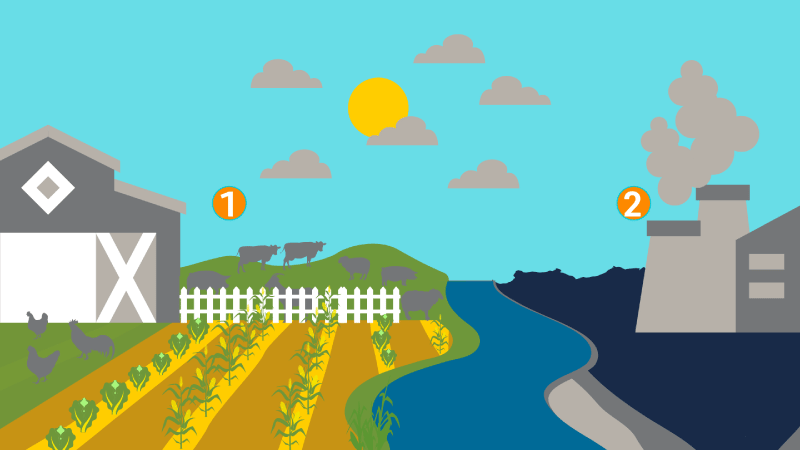
- Eat at least one plant-based meal a day. According to this Science article, "Meat, aquaculture, eggs, and dairy use approximately 83% of the world’s farmland and contribute 56%-58% of agriculture’s greenhouse gas emissions, despite providing only 37% of our protein and 18% of our calories." By eating at least one plant-based meal a day, you can reduce your personal environmental footprint. Incorporating more plant-based meals into your diet can be intimidating if you rely heavily on animal products. Start by selecting plant-based meals twice a week and work your way up from there. You can choose from many varieties of diets, including vegetarian, vegan and more. Companies like Beyond Meat are making it easier than ever to choose plant-based meals. Eating a plant-based diet is easier if you ask friends or family to do it with you. Talk to your doctor if you are concerned about nutrient insufficiencies; you can compensate by eating a well-rounded diet or taking targeted supplements. To learn more about the impact of plant-based eating and tips that can help you make the switch, check out this podcast on plant-based eating by the UC San Diego Inter-Sustainability Council.
- Be aware of the environmental impacts of meat production. CEO of Conservation International, M. Sanjayan, describes in this Vox Climate Lab video that the different types of food we eat have different carbon impacts. For example, a single serving of beef can equate to about 330 grams of carbon, the equivalent to driving three miles, while a single serving of lentils equates to about 2 grams of carbon, a difference of 328 grams! According to the Water Footprint Calculator, it takes 674 gallons of water to produce a six-ounce steak, whereas a simple salad only uses 21 gallons of water. Use this Harvard University Foodprint Calculator to determine the environmental impact of your diet.
Many ugly truths exist about the prominent meat industries. Learn more about the tragic aspects of the meat industry from this Buzzworthy article. If you still feel that meat is essential for your diet, always purchase items with key words like grass-fed, organic, free range and cage-free. Do the necessary research to know that the animal products you are purchasing come from farms that respect animal rights.
Fabrics
Modern fashion and textile industries are two of the most environmentally unfriendly and unethical industries worldwide. “Fast fashion” refers to inexpensive, poor-quality clothing that retailers mass-produce to keep up with current fashion trends. Americans purchase five times as much clothing as they did in 1980 and they discard staggering amounts of unworn clothing. Now, cheaply made clothing is intended to be worn a few times and then replaced to incentivize customers to keep buying more. In the U.S., 85% of consumed clothing ends up going to landfills—almost 3.8 billion pounds annually. By changing your habits, you can have lasting effect on our global systems while you save money.

- Learn to maintain the clothing you have. Few people have much experience with sewing or fabric care so mending their clothing seems difficult. By learning about a few basic stitches and how to treat different types of stains, you can keep the clothing you have had for years looking good as new. In addition, don’t be afraid to ask for help with clothing maintenance; one of your friends or family members may be able to help you build your skills.
- Start modifying your old clothing. Remaking old garments into new ones is a great way to keep clothing in your closet instead of a landfill. In late 1800s England, clothing trends evolved quickly with industrialized production, but high-quality clothing was still quite expensive. In order to keep up with the latest fashions, people got creative with modifying their clothing. For example, women started to sweep their skirts up into bustles to mirror the looks of late Victorian-era clothing. So grab a pair of fabric scissors, a needle and some thread and see what you can make with your old clothes! This Evelyn Wood video gives some good tips on where to start.
- Avoid buying “fast fashion.” Most Americans have a large inventory of unworn clothing sitting in their closets because big clothing brands make cheap clothing so we purchase more items. Often, people are caught up in current fashion trends and always want to be in style. Preventing yourself from frequently buying new clothing may seem daunting, but participating in initiatives, such as UC Merced’s No Fast Fashion February, can reframe your thinking and make it easier!
- Support “slow fashion” and local boutiques. With a bit of research, you can find sustainable alternative clothing sources to fast fashion brands. The garments will be a bit more expensive, but they are typically much higher quality than fast fashion garments because they are made to last. You will ultimately save by buying and wearing sustainable, well-made clothing. Look for companies that use eco-friendly materials, manufacture ethically, are a Certified B Corp and hold other sustainable clothing certifications.
- Repurpose your old clothing. When you are sure that you will never wear something again and you don’t see a way to refashion it or pass it down to family or friends, you don’t have to throw it away! You can cut old shirts into dust rags, make a quilt or rug from old clothing scraps, and more. You can even cut old pieces of clothing into small pieces to stuff pillows, bean bags, etc. Check sites, like Pinterest and YouTube, to get some inspiration, or follow some fashion blogs.
- Expand your awareness of natural fibers. Most household cloth items, such as tablecloths, cushion covers and kitchen towels, are now made using synthetic fabrics (polyester, nylon, etc.), but these synthetics are effectively plastic that shed micro plastics into our environment during production and when they are washed and dried. Using household items made from natural fibers—most commonly wool, linen, recycled cotton and silk—can reduce your environmental impact while providing more comfort. If you can find it, hemp is a very sustainable fabric because it doesn’t require fertilizers, pesticides or much water to grow. Natural and sustainable polyester alternatives, like lyocell, are also available. Many retail websites allow you to filter search results by fabric type. Look for natural fiber options whenever you buy fabric goods.
While natural fibers are generally more sustainable than synthetics, it is still important to pay attention to how they are produced. Cotton is one of the most widely used natural fibers, but it is one of the thirstiest industrial crops. Purchasing goods made with 100% recycled cotton is a good way to get the products you love while saving a lot of water. If you want to buy fabric goods with other fibers, look for linen and hemp; both are breathable and require very little water to grow. In addition, linen comes from the flax plant, which is used completely for production of various goods.
Healthy and Natural Environment
Sometimes we need to be reminded that our actions have consequences. We need to take the necessary steps to conserve and protect the simple things we take for granted, like clean air and water. Preserving our environment now ensures that there will be resources available for future generations. Being conscious of how simple habits have significant environmental impacts is a key step in reducing your personal footprint.
We also need to live in the moment and remember to take care of ourselves. Give yourself and others grace while learning how to implement sustainable practices that can make a big impact.
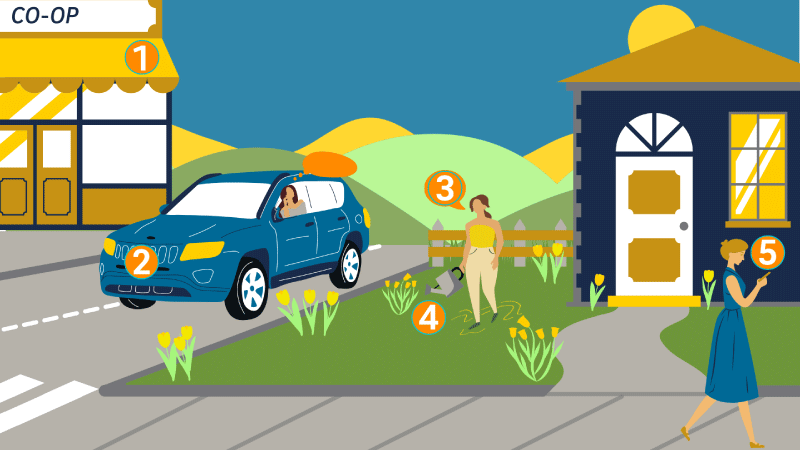
- Support local and small businesses. There are several economic reasons to support your local and small business. In many cases shopping locally means fresher produce from neighboring farmers and a reduction in greenhouse gas emissions from the transportation of goods. Local and small businesses tend to require less space for their operations, moving into already established buildings rather than large shopping centers. Support your local and small businesses by shopping at family-owned establishments, farmer’s markets, and from local artisans. Shopping small can also be done through online platforms like Etsy that make it easy to support artisans. Did you know that Etsy actually carbon-offsets shipping and packaging? This means that the company is actively working towards lowering its environmental impact! The UC System began a Small Business First Program in 2021 to provide more easily accessible business opportunities for certified Small Businesses (SB) and Disabled Veteran Business Enterprises (DVBE).
- Don’t let your car idle unnecessarily. Idling while in the parked position unnecessarily pollutes the environment. Buckle your seatbelt, tune the radio and adjust your seat or mirrors before you start the car and turn off the engine upon arriving at your destination. Idling for more than 10 seconds uses more fuel and produces more emissions that contribute to smog and climate change than stopping and restarting your engine does. Consider instances when you can enter an establishment as opposed to waiting in a drive through. For example, go inside and order at the counter rather than waiting in a line of cars at places like In and Out, Starbucks, and banks. Idling for just one minute produces about a pound of carbon dioxide. If you wait in a drive-through once a week for 10 minutes, after 10 weeks, you could have avoided 100 pounds of CO2 by going inside. Learn more about the impact of vehicle idling.
- Encourage friends and family to engage in sustainable practices. Talking about sustainability is cool! People may not have implemented sustainable practices for many reasons. Some may be motivated by knowing the environmental impact certain actions have on the planet, while others may be motivated by the personal benefits. Whatever the reason, you can share what you’ve learned here with your family and friends to encourage them to take action.
- Water your plants and/or lawn in the early morning or evening. The ideal time to water your outdoor plants is in the early morning or before sunset in the evening because this gives the plants time to absorb the water properly. Watering at night may result in over watering the roots and soil, causing the propagation of fungi and insects. Avoid watering your plants in the middle of the day because rapid evaporation from sunlight often requires more water. Learn more about When to Water.
- Spend some time each day outdoors. Taking a moment to reconnect with nature has significant mental health benefits. One way that being in nature affects your mental wellbeing is that it reduces the stress hormones cortisol and adrenaline in the brain. Think creatively about the different ways that you can get outside during the workday. You can skip the Zoom and participate by phone while you walk or ride a bike to your local eatery to grab a bite. Learn more about how getting outdoors is a key component of mental health maintenance from Sharp.
Transportation
According to the EPA, the transportation sector in the U.S. is one of the largest contributors of greenhouse gas emissions caused by humans. Several options for traveling to, from and around campus have a lower environmental impact. When traveling longer distances for business purposes, consider purchasing carbon offsets from organizations like The Good Traveler to lower your impact from air and ground travel. Carbon offsets are a form of trade that fund projects that reduce greenhouse gas emissions. These projects can include greenhouse gas capture and sequestration or producing energy from cost-intensive, renewable sources.
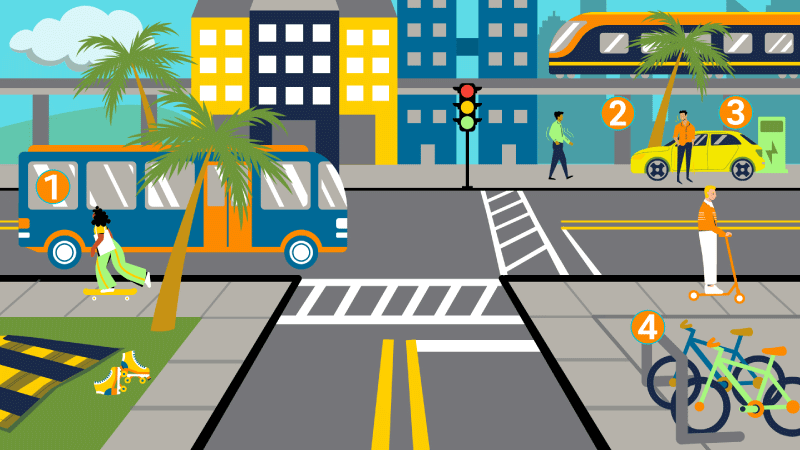
- Take public transit. Public transit is any mode of transportation other than a single-occupancy vehicle. UC San Diego offers different transit programs for faculty, staff, students and affiliates. Soon, Blue Line Trolley service will connect UC San Diego to downtown.
- Get rides from friends or family. Carpooling saves approximately 6 metric tons of carbon dioxide emitted from a single-occupancy vehicle each year and reduces traffic congestion and parking demand.
- Drive a hybrid or electric vehicle. Gasoline-fueled vehicles contributes to air pollution. A hybrid vehicle uses a combination of gasoline and battery storage, wherea an electric vehicle is solely using battery storage. The State of California announced that by 2035, all in-state purchases of new passenger cars and trucks be zero-emission vehicles. The California Air Resource Board administers the Clean Vehicle Rebate Project, which helps Californians submit rebates for purchasing or leasing eligible vehicles. UC San Diego provides students, faculty and staff incentives for purchasing electric vehicles and supports over 300 charging stations around campus.
- Walk, cycle, scoot or skate. UC San Diego is a great campus for walking and using micromobility devices, like bikes, scooters and skateboards to get around. Transportation Services provides programs and infrastructure to help make those choices accessible. Watch this video and visit the Alternative Transportation webpage to learn more.